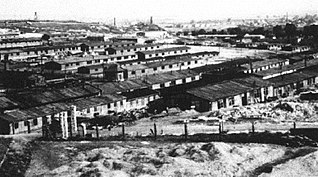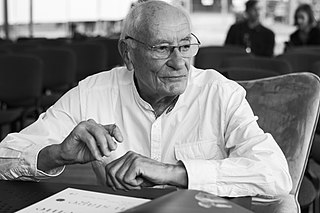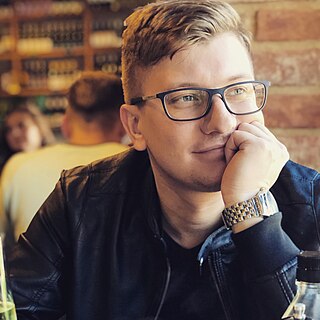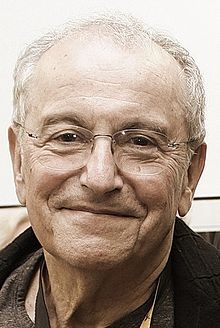
Raymond Roman Thierry Polański is a French and Polish film director, producer, screenwriter, and actor. He is the recipient of numerous accolades, including an Academy Award, two British Academy Film Awards, nine César Awards, two Golden Globe Awards, as well as the Golden Bear and a Palme d'Or.

Schindler's List is a 1993 American epic historical drama film directed and produced by Steven Spielberg and written by Steven Zaillian. It is based on the 1982 novel Schindler's Ark by Australian novelist Thomas Keneally. The film follows Oskar Schindler, a German industrialist who saved more than a thousand mostly Polish-Jewish refugees from the Holocaust by employing them in his factories during World War II. It stars Liam Neeson as Schindler, Ralph Fiennes as SS officer Amon Göth, and Ben Kingsley as Schindler's Jewish accountant Itzhak Stern.

Płaszów or Kraków-Płaszów was a Nazi concentration camp operated by the SS in Płaszów, a southern suburb of Kraków, in the General Governorate of German-occupied Poland. Most of the prisoners were Polish Jews who were targeted for destruction by Nazi Germany during the Holocaust. Many prisoners died because of executions, forced labor, and the poor conditions in the camp. The camp was evacuated in January 1945, before the Red Army's liberation of the area on 20 January.

Richard Avedon was an American fashion and portrait photographer. He worked for Harper's Bazaar, Vogue and Elle specializing in capturing movement in still pictures of fashion, theater and dance. An obituary published in The New York Times said that "his fashion and portrait photographs helped define America's image of style, beauty and culture for the last half-century".

The Kraków Ghetto was one of five major metropolitan Nazi ghettos created by Germany in the new General Government territory during the German occupation of Poland in World War II. It was established for the purpose of exploitation, terror, and persecution of local Polish Jews. The ghetto was later used as a staging area for separating the "able workers" from those to be deported to extermination camps in Operation Reinhard. The ghetto was liquidated between June 1942 and March 1943, with most of its inhabitants deported to the Belzec extermination camp as well as to Płaszów slave-labor camp, and Auschwitz concentration camp, 60 kilometres (37 mi) rail distance.

The Schindlerjuden, literally translated from German as "Schindler Jews", were a group of roughly 1,200 Jews saved by Oskar Schindler during the Holocaust. They survived the years of the Nazi regime primarily through the intervention of Schindler, who afforded them protected status as industrial workers at his enamelware factory in Kraków, capital of the General Government, and after 1944, in an armaments factory in occupied Czechoslovakia. There, they avoided being sent to death camps and survived the war. Schindler expended his personal fortune made as an industrialist to save the Schindlerjuden.

The Leon Schiller National Film School is a Polish academy for future actors, directors, photographers, camera operators and television staff. It was founded on 8 March 1948 in Łódź (Lodz).

Art Kane was an American fashion and music photographer active from the 1950s through the early 1990s. He created many portraits of contemporary musicians, including Bob Dylan, Jefferson Airplane, Sonny and Cher, Aretha Franklin, Frank Zappa, Jim Morrison, Janis Joplin, the Rolling Stones, and The Who.

Podgórze is a district of Kraków, Poland, situated on the right (southern) bank of the Vistula River, at the foot of Lasota Hill. The district was subdivided in 1990 into six new districts, see present-day districts of Kraków for more details. The name Podgórze roughly translates as the base of a hill. Initially a small settlement, in the years following the First Partition of Poland the town's development was promoted by the Austria-Hungary Emperor Joseph II who in 1784 granted it the city status, as the Royal Free City of Podgórze. In the following years it was a self-governing administrative unit. After the Third Partition of Poland in 1795 and the takeover of the entire city by the Empire, Podgórze lost its political role of an independent suburb across the river from the Old Town.
Leopold "Poldek" Pfefferberg, also known as Leopold Page, was a Polish-American Holocaust survivor who inspired the Australian writer Thomas Keneally to write the Booker prize-winning novel Schindler's Ark, which in turn was the basis for Steven Spielberg's critically acclaimed 1993 film Schindler's List.

Allan Mieczysław Starski is a Polish Oscar-winning production designer and set decorator.

Jan Brunon Bułhak (1876–1950) was an early 20th century photographer in Poland and present-day Belarus and Lithuania. A published theoretician and philosopher of photography, he was an exponent of pictorialism. He is best known for his landscapes and photographs of various places, especially the city of Vilnius. He was the founder of the Wilno Photoclub and Polish Photoclub, the predecessors of the modern Union of Polish Art Photographers (ZPAF), of which he was an honorary office-holder. He is also known as an ethnographer and folklorist.

Yasuhiro Wakabayashi, known professionally as Hiro (ヒロ), was a Japanese-born American commercial photographer. He was known for his fashion and still life photography from the mid-1960s onward.

Wilhelm Brasse was a Polish professional photographer and a prisoner in Auschwitz during World War II. He became known as the "famous photographer of Auschwitz concentration camp." His life and work were the subject of the 2005 Polish television documentary film The Portraitist (Portrecista), which first aired in the Proud to Present series on the Polish TVP1 on 1 January 2006.

The Auschwitz-Birkenau State Museum is a museum on the site of the Auschwitz concentration camp in Oświęcim, Poland.

Wojciech Plewiński is a Polish photographer. His photos were published on over five hundred „Przekrój” magazine covers. He is a member of FIAP and ZPAF.
The New York school of photography is identified by Jane Livingston as "a loosely defined group of photographers who lived and worked in New York City during the 1930s, 1940s and 1950s" and who, although disinclined to commit themselves to any group or belief, "shared a number of influences, aesthetic assumptions, subjects, and stylistic earmarks". Livingston writes that their work was marked by humanism, a tough-minded style, photojournalistic techniques, the influence of film noir and the photographers Lewis Hine, Walker Evans, and Henri Cartier-Bresson; and that it avoided "the anecdotal descriptiveness of most photojournalism" and the egoism of American action painting, and indeed that it was remarkably little influenced by contemporary painting or graphic design. Livingston selects as key exponents of the New York school of photography Diane Arbus, Richard Avedon, Alexey Brodovitch, Ted Croner, Bruce Davidson, Don Donaghy, Louis Faurer, Robert Frank, Sid Grossman, William Klein, Saul Leiter, Leon Levinstein, Helen Levitt, Lisette Model, David Vestal, and Weegee.

Mateusz Kudła is a Polish film producer, director, TV reporter, and YouTuber.

Apel is a 1970 black-and-white cutout animated short film by Ryszard Czekała.
Lech Polcyn is a Polish graphic artist, photographer and painter, professor at the Academy of Fine Arts in Kraków.

















